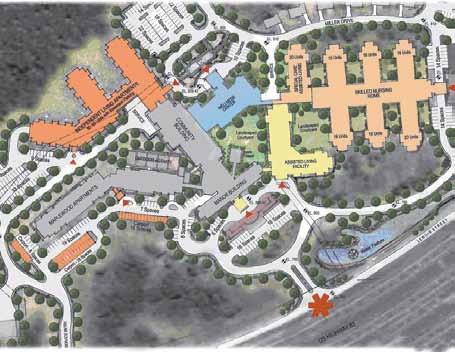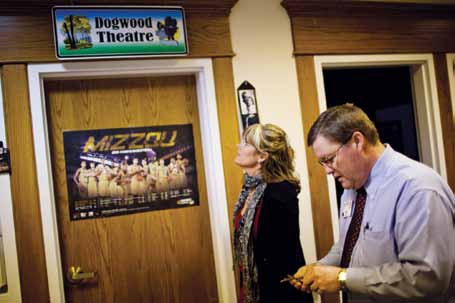Lenoir Woods plans expansion, shift in care model
In two years, a barber shop will replace Kent Kirkwood’s office at Lenoir Woods. A bank will move in across the hall and a general store a few doors down.
But Kirkwood, executive director of the continuing care retirement community, isn’t moving out. He’s just moving to another spot in the same building, which is gearing up for a massive renovation.
“When you look down this hallway, it will actually look like Main Street,” Kirkwood said, gesturing toward the hallway’s walls, where signs advertising the standard businesses of a small downtown will hang.
Interior designers for Lutheran Senior Services studied Columbia’s main commercial street, Broadway, to come up with a design for the main community building of Lenoir Woods’ 110-acre campus on the southeastern edge of the city limits.
But Columbia’s largest retirement community plans to go far beyond renovation. During the next three to five years, LSS intends to invest $50 million in new buildings and facilities on its campus, which already serves some 450 seniors and employs about 200 people. Plans call for at least 50 new independent living apartments, a new assisted living facility and a wellness center.
LSS also plans to relocate its skilled nursing facility from the northwest corner of the property to a spot amidst its other buildings. Administrators asked the Columbia Planning Department to amend the zoning code to accommodate the move, which they say will help residents requiring specialized care to stay involved in the Lenoir community.
“When (residents) have a husband or wife that’s over in the care center … right now you have to go over a bridge and actually go outside your building to physically go visit them,” Kirkwood said. “This will get it all under one roof.”
On Jan. 3, the City Council approved the change to the zoning code, which allows continuing care retirement communities such as Lenoir to build care and assisted living facilities in residentially zoned areas. That keeps them from having to rezone the area to office and allows other retirement communities to consolidate the operations into facilities that can accommodate all levels of care, Columbia Development Services Manager Pat Zenner said.

Ultimately, it’s an economic development opportunity, Zenner said. The zoning change accommodates a model that is becoming preferred among retirement communities, he said, and it will hopefully attract other care communities. Plus, allowing care facility operators to build communities attractive to seniors will increase incentives for more of them to live out their golden years in town, he said.

The planned renovations are part of a culture shift at the Lenoir Woods community that has been underway since it was purchased through bankruptcy from the National Benevolent Association, a social services division of the Christian Church Disciples of Christ, in 2005. Lenoir has refocused its mission to concentrate solely on senior care and dropped a day care center for children in early 2009. The consolidation of facilities under one roof and a more home-based model of care are part of that shift, according to Jill Layne, administrator of the health care center at Lenoir.
“It’s a shift from a more institutionalized retirement community to a more personalized retirement community,” she said. “They wanted something that was more like home to them.”

“The (Missouri) Department of Health and Senior Services has really been on board with all of this,” Layne said.
The nursing care industry as a whole is in the midst of a shift toward a less institutionalized model, Kirkwood said.
“Long-term care in the nursing home industry, the history has been based on the hospital model until this time,” Kirkwood said. “We’re in a renaissance, or a rebirth of everything that we do.”
The shift in culture and expansion at Lenoir reflects the growing clout and demands of a swelling elderly population. With the first baby boomers just entering retirement, Lenoir is expanding its units to meet demand that will continue rising for years.
“The market studies show there’s a need,” Kirkwood said. “We’ve still got the baby boomers to come, and we’re preparing for the baby boomers right now.”
Target dates for completing the renovations and expansions are still in flux because the planning process just shifted to high gear, Kirkwood and Layne said. Plus, they have to be careful about making promises they can’t keep; their residents read the paper.
“We give a date, our residents hold us to it,” Kirkwood said laughing.


